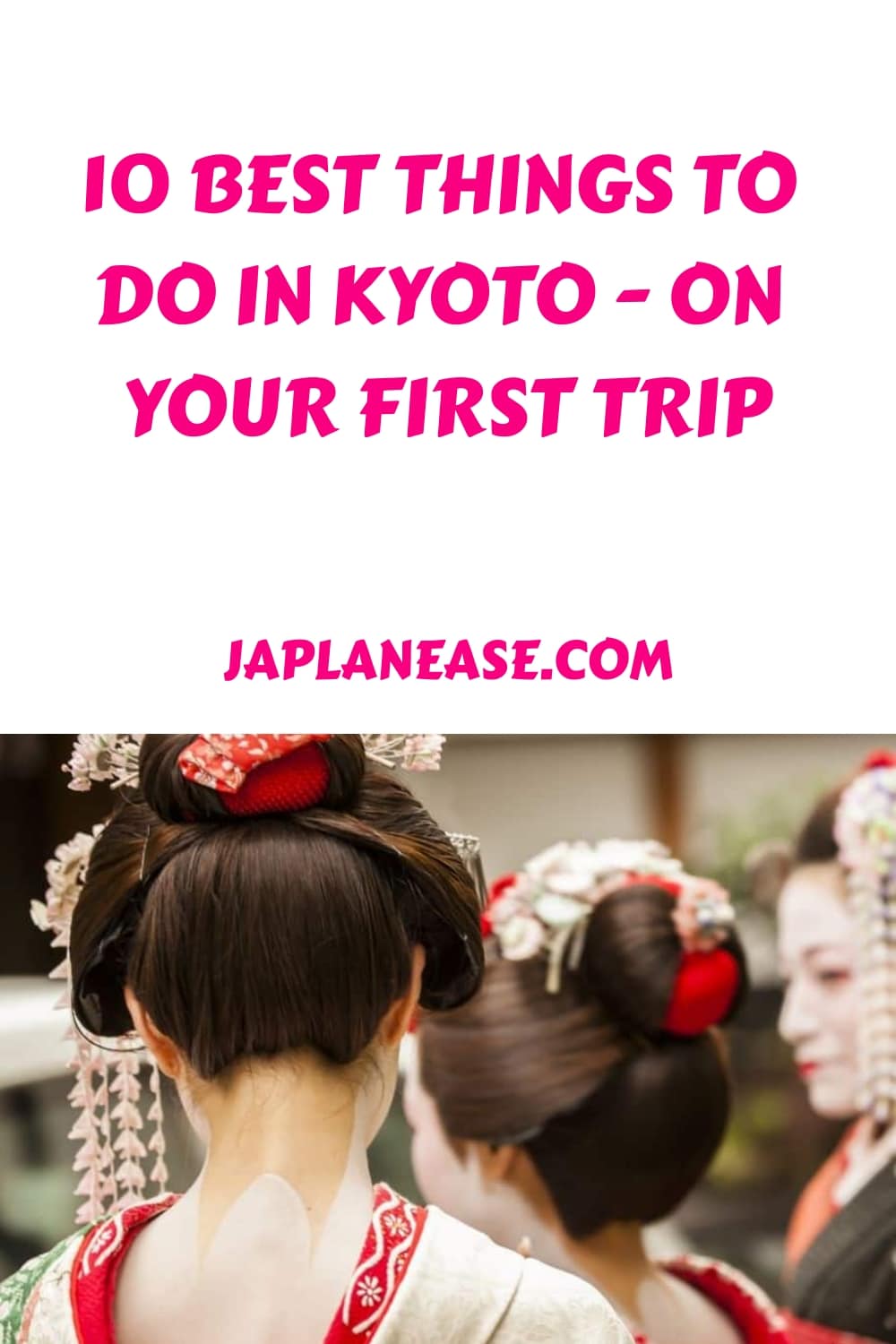- How to Spend One Day in Matsumoto - 18 December 2025
- How Long Should You Spend at the Tokyo Disney Parks in Japan? - 16 December 2025
- Why ‘Waste’ a Day in Japan at Tokyo Disney or USJ? - 16 December 2025
Kyoto is one of Japan’s oldest and most beautiful cities It’s steeped in history, full of temples, and has a lot to pack into a short trip. So, what should you do on your first visit to Kyoto? Here are our top ten suggestions to get a rounded view of all the city – not just visit shrines and temples!
Kyoto is a little over two hours’ bullet train ride away from Tokyo. This makes it a great place to combine with Tokyo on your first Japan trip—not least because the two cities couldn’t be more different.
Where Tokyo is modern and full of bright lights, the fact that it wasn’t bombed in the Second World War means that much of Kyoto dates back centuries—and that heritage is preserved throughout the city. Even the Starbucks in Kyoto blends into the aesthetic.
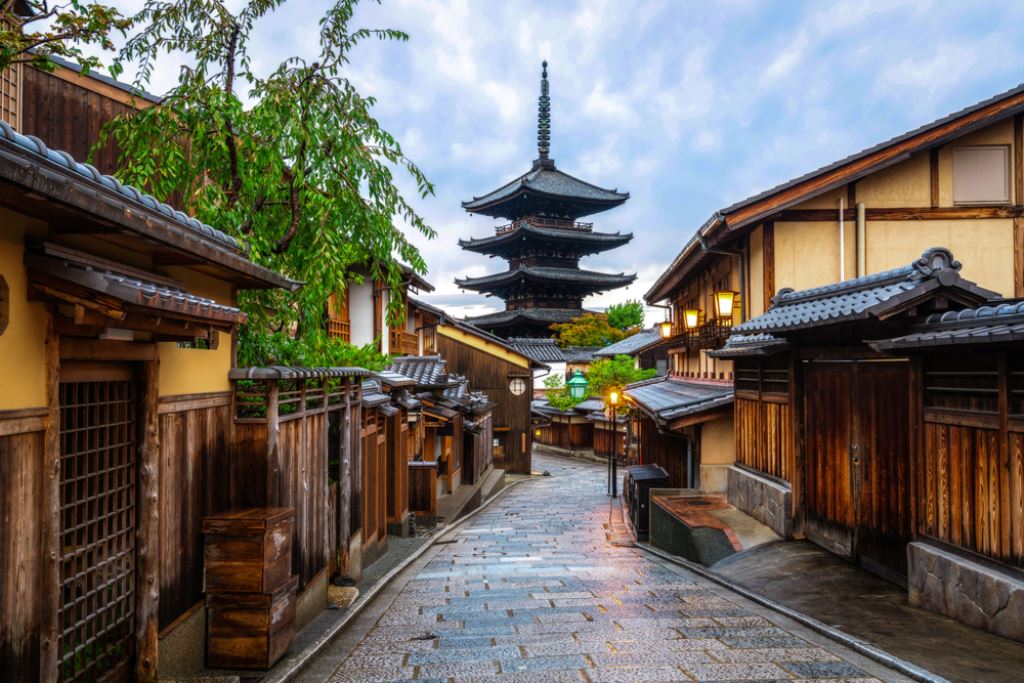
Article by Helen Foster. Disclosure: Some links in this post are affiliate links. See our Affiliate Disclosure.
But it’s not a small city and there’s a lot of choices of things to see – many of them of the temple and shrine variety.
As such most lists of the best things to do in Kyoto are just a list of shrines and temples, but in our list, we’re aiming to explore a bit more of the city – although, as our first suggestion shows, you’re going to end up in at least one religious establishment on this trip… but it’s a beauty.
1. Climb Fushimi Inari Taisha
Of all the temples in Kyoto, this is the one that is on everyone’s must-see list. It’s one of Kyoto’s top attractions. And deservedly so.
Located on a hill, the shrine has over ten thousand bright red gates, and the sight of them winding up the hill, stretching out in front of you as far as you can see, is truly a sight to behold.
Walking all the way up to the top involves a 4km climb, but you don’t have to go all the way to the top to experience the shrine; most people don’t – but, if you do keep going, eventually you will finally get a photograph without people in it!
The other way to beat the crowds is to arrive early in the morning or shortly before dusk – the shrine is open 24 hours a day so, you can time your visit outside for the busiest hours.
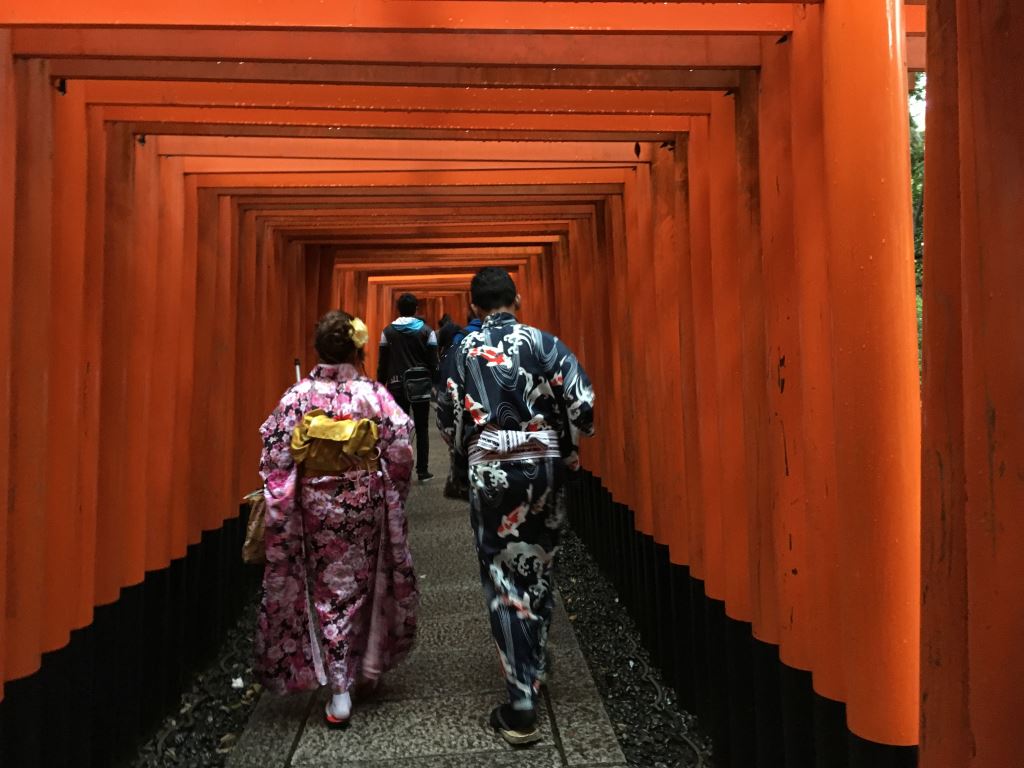
Take some time to look around the shrine buildings themselves before you rush up to the torii tunnel. The ema plaques here are particularly cute.
Closest Station
There are two stations close to Fushimi Inari Taisha; Inari is on the JR line (which means the journey will be free on your JR pass) and is closest to the entrance.
You can catch this from Kyoto station.
Or, if you’re coming from the middle of Kyoto, take the Keihan Main Line, which takes you to Fushimi Inari station, a short walk away.
What Else is Nearby
Fushimi Inari Taisha isn’t that near any other big Kyoto sites, but there are some shops and restaurants near the entrance that you can explore. If you’re exploring off the beaten track a little bit, you can also explore the Fushimi sake area or, wander around the smaller shrines near Fushimi Inari. Some of these are very pretty and peaceful. I really liked Komyo-in.
It’s also an easy journey from Fuhsimi Inari to Nara if you want to go and see the deer and a few of the major sights in Nara. You can easily combine the two in a day if time is tight.
2. Visit at Least One Other Shrine or Temple
Shines and temples are the most common places to visit in Kyoto. You could spend an entire week in Kyoto and still not see every one of them.
There are over 1400 of them after all – but there are some clear scene stealers, Fushimi Inari is one, others include Kinkaku-ji with its shimmering gold walls, Kiyomizu-Dera (below), which is particularly beautiful in autumn (but incredibly busy) – and my personal favorite, Otagi Nenbetsu-ji, with its thousands of tiny stone figures.
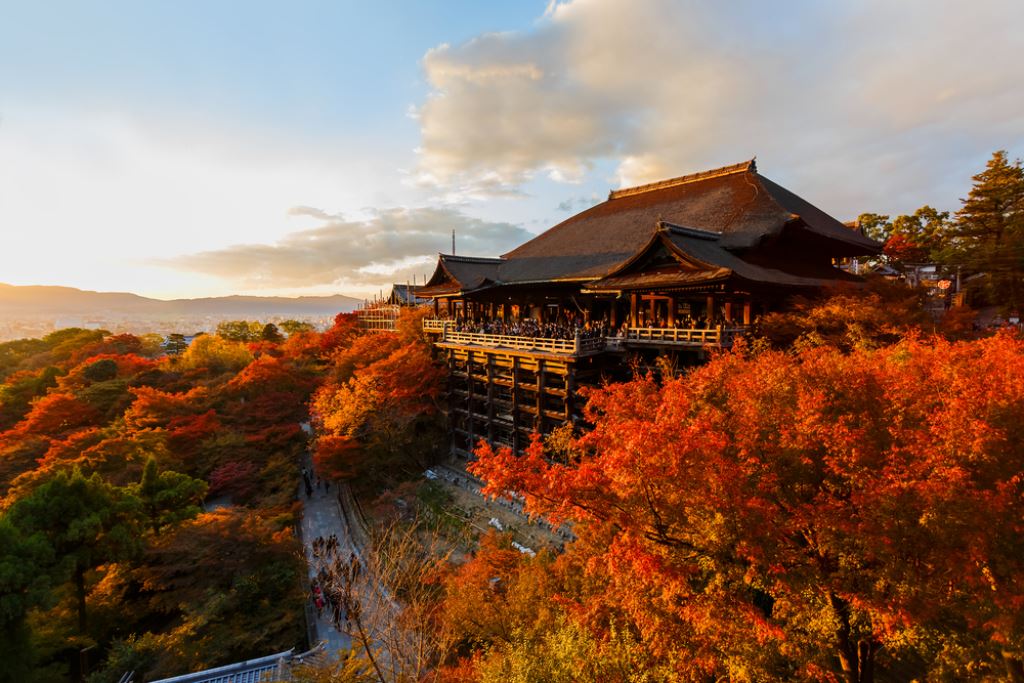
Decide which of the top temples you can’t miss and which are optional extras if you have enough time and energy, then do the best you can.
Do note though, the distances in Kyoto are quite large, and, train routes don’t always get you as close to the big ticket items so sightseeing in Kyoto isn’t always as easy as in Tokyo or Osaka.
If you are going to try and see as many temples as possible, plan your days well so you’re not backtracking on yourself too much. And try to get a handle on the buses.
3. Listen to Arishyama Bamboo Forest
I admit, after all the Insta-hype when I actually first arrived here and saw it, I was decidedly unimpressed. The word ‘twigs’ was used. But it is beautiful in its own way – and as it’s one of the main attractions in Kyoto, I’d be remiss not to talk about it.
But do be warned—it’s not as green and lush as it looks on everyone’s Instagram pictures. If you want to get pictures without lots of other people in them (without using clever camera trickery), I can’t stress enough how important it is to get up early and go first thing in the morning.
The picture here was taken at about 8am and shot quickly when the people in front went around the corner.
Within a few hours, the place was back-to-back people.
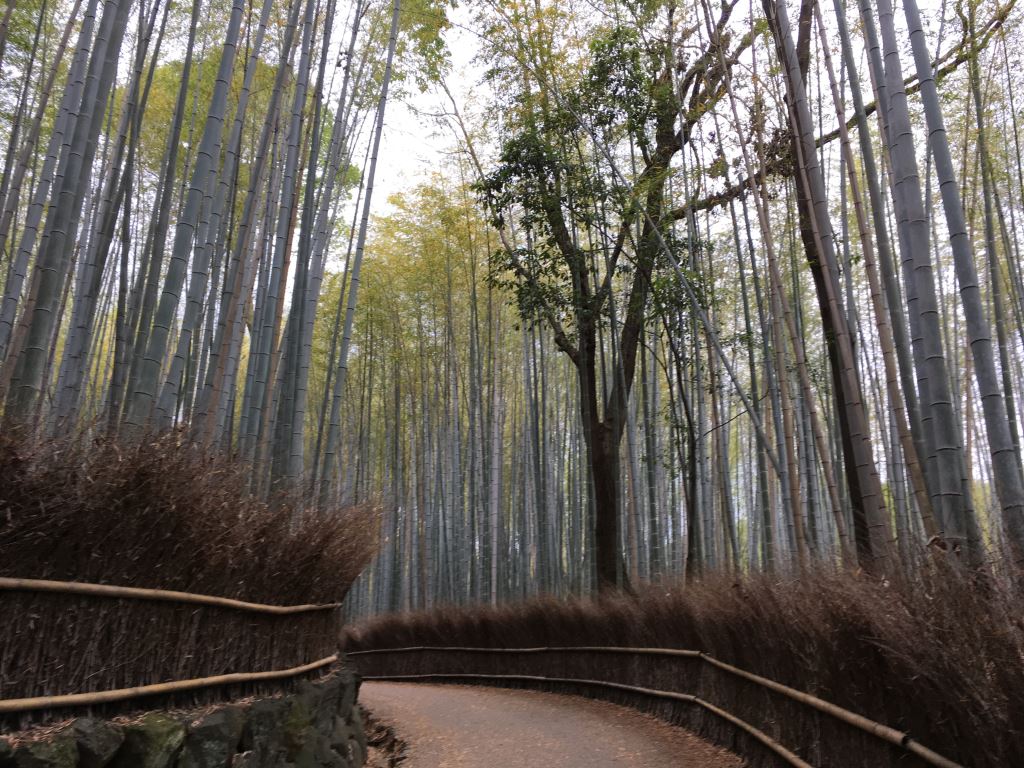
However, if you get here early without preconceived ideas from Instagram, you can’t help but appreciate the peace and tranquillity of the place and the fact that the forest is still untouched in the middle of the city.
Also, take some time to listen to the bamboo clacking; the sound of the forest is actually a protected soundscape (and one of our 17 small things not to miss in Japan).
Closest Station
The Bamboo Forest is located in Arishiyama, which is in east Kyoto.
There are two nearby stations: Saga Arashiyama, which is a JR station, or you can arrive at Arishayama on the Randen line.
What Else is Nearby
Lots. A visit to Arishayama can easily take up a whole day of your Kyoto trip. Highlights are Otagi Nenbetsu-ji, the beautiful gardens of the Okochi-Sansa Villa and the pretty Kimono Forest at Arishayama station. It’s also home to the monkey park (see below).
Don’t Miss The Sagano Romantic Train
The Sagano Romantic Train also departs from Arashiyama. This 50-minute return train trip takes you through the local ravine and is a must-do if you’re here in Autumn. If you’re on a longer trip, it’s definitely worth adding to your day in Arashiyama – if only as a nice way to rest your feet for an hour!
If you are here for the fall foliage, (and to be sure of a seat at other times), you’ll need to book your seat early – reservations open a month before your departure day.
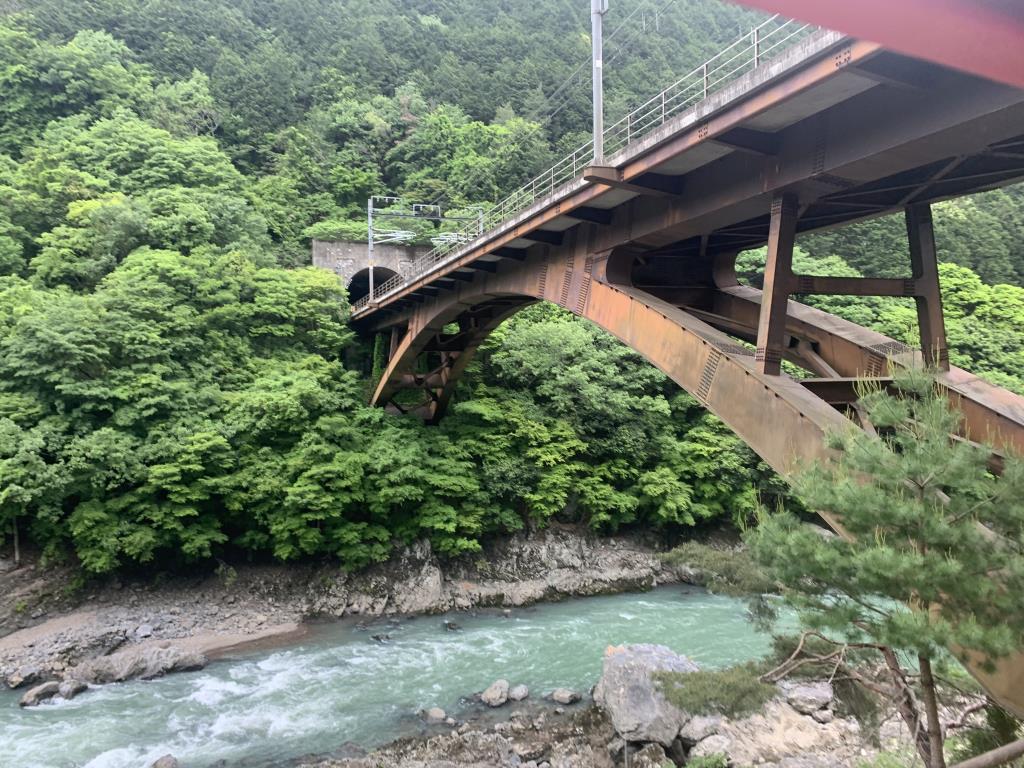
The English site has the schedule and an explanation of how to book.
Or, you can book tickets via Klook. See more about those here.
A top tip that I discovered when I rode the train: book seats on the right-hand side. They have the best views of the river that runs alongside the tracks and the cute tanukis lined up at the station. I was on a seat D on the left the way out and, even though it was a window seat, the views were nowhere near as good.
4. Have Tea With a Geisha or Maiko
Kyoto is renowned for geisha culture (or geiko as they are known in Kyoto), and anyone who has read Arthur Golden’s Memoirs of a Geisha will be fascinated by this ancient city and the role the women of the geisha tradition have played within it.
However, this has meant that geiko has become a bit like the Kyoto equivalent of a lion on a safari, with people lying in wait to get a picture of them as they come to work, chasing them down streets and even grabbing them.
The result is that Kyoto has severely clamped down on photography of geiko (and even brought in fines in some areas), particularly in Gion, the main area where you might spot them.
Read about the new rules in Gion banning tourists from some roads in the area.

Don’t break the rules.
If you are lucky enough to see a geiko entering her teahouse to work, appreciate how lucky you are, respectfully admire how beautiful she looks – and don’t be that person waving a camera in her face.
A better way to get up close and personal with geiko is to book a tea ceremony or dance performance by a geiko, or, a maiko (a trainee geisha). Or, to find out about the lifestyle, book one of the tours that involve a chat with a current, or retired geisha.
You’ll find a selection of these run by Gion Maikoya, some of which include dressing up in a kimono yourself.
Their website is also a great way to learn more about the life of a geisha or maiko.
Or Book Tea with a Tea Master
Another authentic tea ceremony experience is to take tea served by a tea master in a temple. We tried the Ju An Tea Ceremony at Jotokuji and really enjoyed it.
It’s split into three parts – including a chance for you to perfect your own matcha-making skills.
Book via the link above, or, if you’d like more information read our full review of Ju An Tea Ceremony.
5. Nibble Through Nishiki Market
If you’ve already clicked around this blog a bit, you’ll know that I love markets – and Nishiki Market in Kyoto is definitely one of the most fun ones I’ve been to.
It’s a long line of shop after shop after shop selling everything from white strawberries to tiny cakes shaped like hedgehogs.
If you’re looking for cute food souvenirs, then you’ll definitely want to make a stop here.
The speciality of the market though is a sticky sweet baby octopus with a quail egg in its head. If you’re brave enough to try one (they aren’t bad actually) you get a sticker to carry with pride!
If you want to learn about food as you travel the market, then you might want to book a food tour – like this one. You’ll then go to the best stalls and learn a bit about the food you’re eating and the stall holders who made it for you.
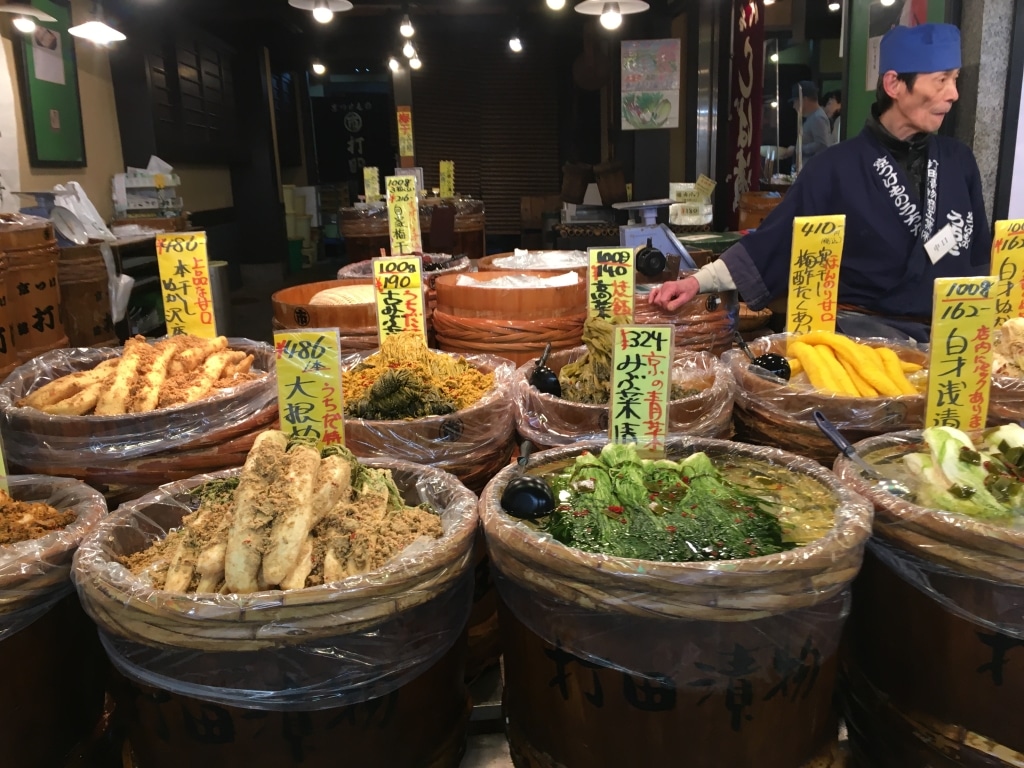
Closest Station
Nishiki is in the middle of downtown Kyoto and kind of located in a square between lots of stations.
The absolute closest are Karasuma or Kyoto Karawamachi on the Hankyu- Kyoto line, but, if you’re already in downtown, it’s probably just as easy to walk there.
What Else is Nearby
Nishiki Market is easily combined with most of the main sights in the middle of the city – it’s about a 20-minute walk from Gion and 25 minutes from Higashiyama.
If you’re looking for something in the immediate vicinity, though, I really like the Teramachui and Shinyogoku Shopping Streets. They have a cool retro atmosphere, tiny shrines tucked around corners and it’s a great place to wander and get lost.
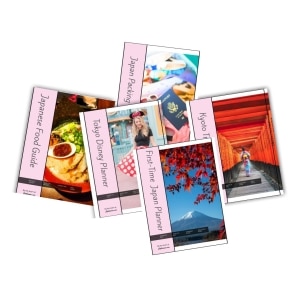
Need Extra Planning Help?
Our Japan trip planners can help. You might like our First-Timers Japan Planner, which will help you plan your trip to Tokyo, Kyoto and Osaka step-by-step, including tips on everything from picking hotels to sightseeing and dining. Or our super-duper Tokyo Disney Planner makes arranging your park trip MUCH easier. Find them in our Planners store – printable and digital versions are available.
6. Wander Higashiyama
This area offers a lot of sightseeing bang for its buck! And is a Kyoto must-see.
It’s one of Kyoto’s most historic areas. The streets are lined with the small wooden buildings (called machiya) that Kyoto is known for and even if a lot of them now contain shops aimed at tourists that doesn’t make it any less atmospheric.
RELATED READ: You can stay in some machiya – in Kyoto. See more in our list of different types of accommodation in Japan, here.
Definitely head to the pretty Nineizaka area with its cute streets; you’ll also find the picturesque Yasaka no to Pagoda and a temple full of pom poms (Yasaka Koshindo) while you wander Higashiyama.
The area is a must-see if you’re here in March when it hosts the Hanatoro Lantern and Flower Festival – although expect crowds.
I have to admit to not having fallen for Kyoto in a big way (so far) but I love Higashiyama. I think it’s one of the most beautiful places in Kyoto.

Nearest Station
Kiyomizu-Gojo and Gion Shijo on the Keihan Main Line are both around a 15-minute walk from the main sights in Higashiyama.
What Else is Nearby
Kiyomizu-Dera is located on the edge of Higashiyama so you might want to start your day here when the shrine opens (as early as 6am) and then head to Nineizaka before the crowds.
Make sure you take the pretty route up the Sannenzaka Slope (above) to do this. Then, you can wander around the shops once things start to open up.
If you’re here in cherry blossom season, then you’ll probably also want to visit nearby Maruyama Park as it’s one of the best places in Kyoto to see the flowers.
Can You See The Main Sights in One Day?
Not all of them, but if you don’t have long in Kyoto, you might want to take in the most popular sights – Arishiyama Bamboo Grove, Fushimi Inari, Kiyomizu-dera and Higashiyama – in one day. It’s a bit rushed, but you can do it – and here’s our plan to spend one day in Kyoto and see the highlights.
7. See Yokai Street
It’s not on most ‘sights to see in Kyoto’ lists but this quirky little street was one of the main reasons I went to Kyoto on one of my previous trips. If you are interested in Japanese legends, or, are traveling with children who are getting a bit templed out, it’s a fun stop.
Yokai is the Japanese name for all things supernatural – ghosts, monsters, and spirits – and, the story of Kyoto’s Yokai Street is that one day, during Japan’s spring cleaning season, all the household objects people had thrown away came to life, and marched down the street to protest.
A set of priests calmed things down, but the street now celebrates their importance by placing models of them outside the shops. They’re pretty cute.
There are also some other yokai-themed meals and shops around the street. You’ll find a full write-up on Japlanease’s sister blog Differentville.
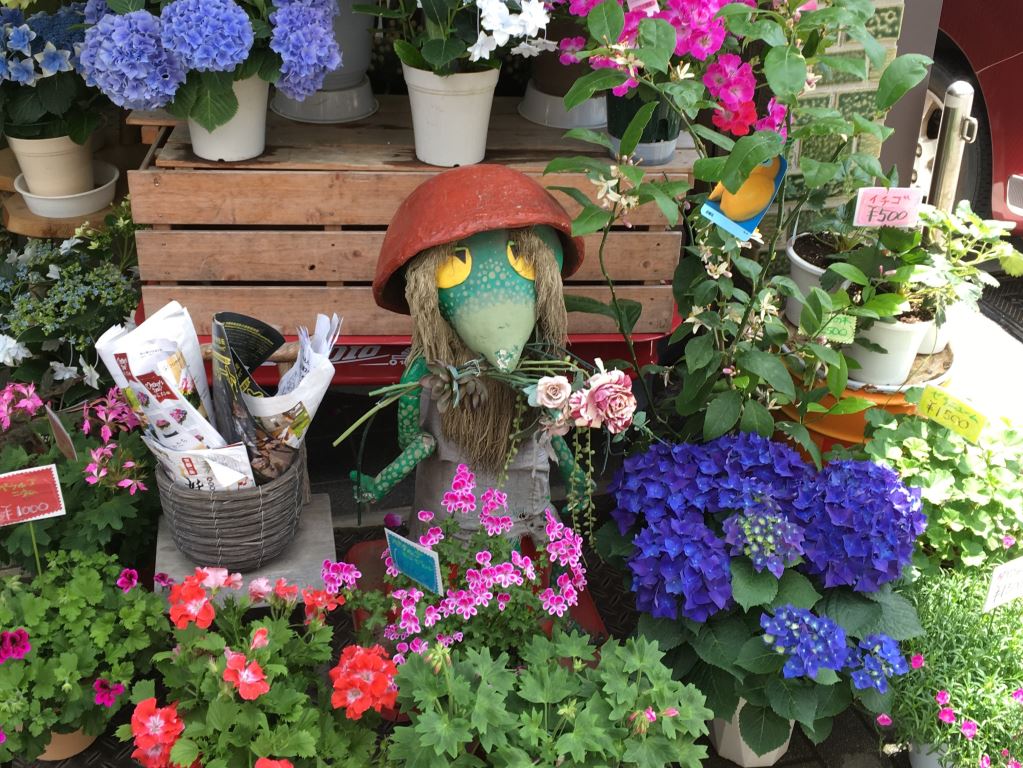
You must go when the shops are open as it’s the owners that put the yokai out into the streets.
That also gives you a chance to wander around some more local shops though – my friend Kendall was thrilled with the Japanese material offcuts she found at the fabric shop at the end.
Nearest Station
The closest station to reach it is Kitanohakubaicho which is just a few minutes walk away.
Yokai Street is part of a large road called Ichijo Dori and the monsters appear on the east side between Nishioji-street and the end of the street where the road turns into Nakadachiuri-street. Head toward the junction with Tenjin Dori and you’ll start to see them appear.
The first one we spotted was at the florist which is named Sakurai Hanaten Co on Google Maps.
What Else is Nearby
The street itself is in a very local area, but it’s only about a 20-minute walk from Kinkaku-ji (the Golden Temple) or 25-minute walk from Royan-ji and its famous Zen garden.
The Randen Line also runs from Arishayama to Kitanohakubiacho making a trip to Yokai Street easy to combine with the sights here if you don’t have a lot of time.
Save Money with Klook & Japlanease
If you plan on buying tickets or tours from Klook for when you’re in Japan, you could save up to 10 per cent by using the code JAPLANEASEKLOOK at the checkout. Click here to see what’s on offer.
T&Cs apply. Some items, including Tokyo Disney and USJ tickets, are not available for discounts.
8. Iwatayama Monkey Park
If you read our piece on Kyoto vs Osaka, you’ll see that I suggest that if you’re traveling with children, Osaka might be a better place to base yourself as Kyoto’s attractions tend to be more culture or adult-focused – this is one of the exceptions.
As the title might suggest, it’s a good place to see some of the Japanese macaque monkeys that you might be more used to seeing soaking in snowy hot springs.
These ones don’t have a bath, but they do have a small forest to jump around in – and they’re completely wild.
Unfortunately, I can’t tell you what it’s like personally, as I really don’t like monkeys. I can even say ‘I don’t like monkeys’ in Japanese as when my Japanese teacher asked for an example of something I hated it was them or coffee!
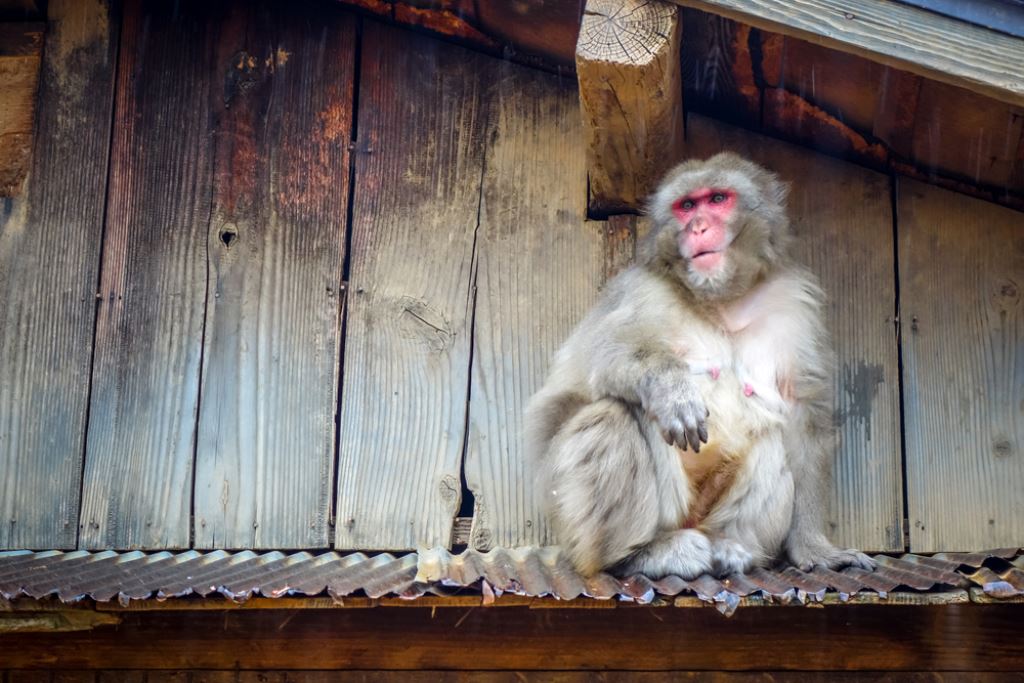
However, if you’re not monkey-phobe and it isn’t the right season to travel to the Snow Monkeys, this forest full of Japanese macaques is a good place to get your monkey fix – and also a nice view of Kyoto from above as the park is on a slope (it’s fairly steep so be warned if you’re not that mobile).
The monkeys are wild, but used to humans which means the braver ones may come quite close as you walk up the path through the park (this is my idea of a nightmare).
If you want to feed them (shudder), you enter a caged area – and feed them through the bars.
If that sounds cruel, I hasten to add, that it’s the people in the cage, not the monkeys.
Nearest Station
Arashiyama Station on the Randen Line is probably the most useful for tourists coming from central Kyoto.
There is another Arishiyama Station (yes, there are two named the same in totally different places) on the Hankyu Arashiyama line.
While this is close to the park, the line probably doesn’t run that near where you’re going to be staying. If it does, however, this works too.
What Else is Nearby
All the sights of Arashiyama, and you get to walk across the pretty Togetsu Bridge to reach the park itself.
9. Walk The Philosopher’s Path
Talking of walking somewhere pretty. The Philosopher’s Path is a walking track lined with trees that connects the very top of Higashiyama with the area close to Gingkakuji – aka the Silver Pavilion.
It’s just over 1.5km long and very pretty – during cherry blossom season it’s stunning, but also very busy.
There are lots of small temples off the path to visit (this gives a good idea of some highlights) and you’ll also find cafes and restaurants to stop at.
The path gets its name as it was a frequent walk for Kitaro Nishida, a philosopher who lived in Kyoto. He’d use the path when he needed time to think.
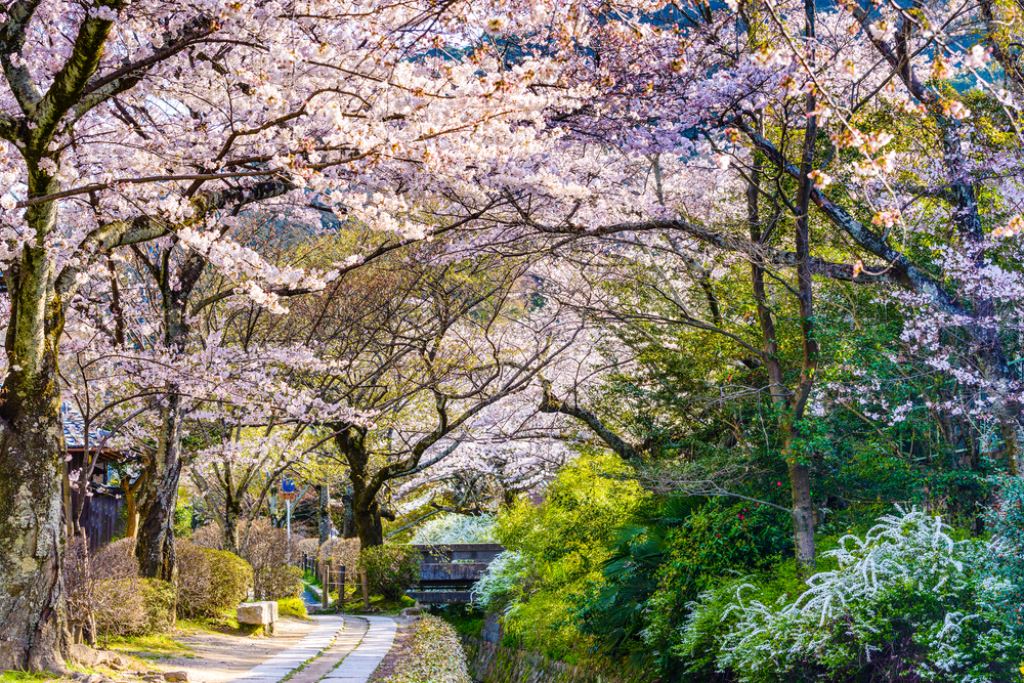
If you’re in Kyoto during Summer, the path becomes home to fireflies so you might want to add a visit in the evening to your Kyoto plans.
Nearest Station
If you start at the south end of the path, your nearest station is Jingu Maratumachi on the Keihan Main Line which is a 30-minute walk away.
At the northern end, Demachiyanagi on the Kiehan or Eizan lines is closest and about 20 minutes from the path.
What Else is Nearby
As we said, the Philosopher’s Path connects two big Kyoto attractions and so it’s easy to combine with a visit to Gingkakuji or Higashiyama.
10. Stay in a Ryokan
A ryokan is a traditional Japanese inn. The floors will be made from traditional tatami mats, you’ll sleep on a futon, and in the posher ryokan, you might have a private onsen and your meals included.
While you’ll find ryokan all over Japan, if you’re on your first trip to Japan and are only visiting Tokyo and Kyoto, Kyoto is the best place to have the experience of staying in one.
The city lends itself to the tradition and ritual of a ryokan – and, depending on where you stay, you might also get to experience the delicate (but usually rather expensive), multi-course ‘kaiseki’ meal that Kyoto is famous for including in your hotel price.
Kyoto has a huge number of ryokan to choose from at different price points which opens up the experience to those who might not want to spend a fortune on their stay.
Because the ryokan is very much designed to be a ‘stay inside and experience it’ visit, especially in the evening, you might not want to spend your whole Kyoto trip in the more exclusive ryokan and just book in for a night or two. It’s also one of the times when we suggest you spend longer in Kyoto (see our guide to help you decide on how long to stay in Kyoto for more advice)
Some Ryokan To Consider
Two of the most exclusive ryokan in Kyoto, Tawaraya Ryokan, and Hiiragiya need you to book directly with them, a few make it a bit easier for us tourists though, and have listed themselves on the main booking engines.
Here are a few to look at…
Arashiyama Benkei
Highly rated on booking.com and offers indoor and outdoor onsen and dinner can be served in your room.
It’s not inexpensive, but if it’s a honeymoon, or a one-night, once-in-a-lifetime experience why not splash out! It looks gorgeous.
Check out rates and pictures for Arashiyama Benkei here.
Yuzuya Ryokan
Also comes highly recommended. It offers a private onsen and pretty gardens. It’s located in central Kyoto which makes it great for exploring – if you do decide to leave.
Check out rates and pictures for Yuzuya Ryokan here.
Tamahan
Smaller, but also traditional – and, more budget-friendly than the ones above!
Have a look at more details on Tamahan here.
Yadoya Kitokuso
If you don’t mind sharing a bathroom, Yadoya Kitokuso offers a beautiful traditional experience. Guests say they’re made to feel like one of the family.
Have a look at pictures and rates for Yadoya Kitokuso here.
There are many, many options to choose from though so if you do want to add staying in a ryokan to your list of things to do in Kyoto, spend an evening hunting through them all.
Things to look at are the size of the room, whether they have their own bathroom, whether they have an onsen (and if that’s private or shared), and what meals are included.
Find a list of Kyoto ryokan here – just remember to select Ryokan on the side panel to screen out the other types of accommodation.
So, there you have it – our list of the 10 best things to do in Kyoto on your first trip (that aren’t all temples or shrines!). What did I miss? Do you have a favourite Kyoto sight that you think I should have included – let me know in the comments.
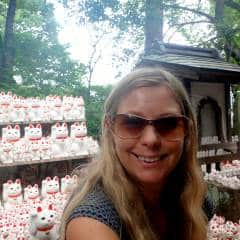
Who Writes This Blog?
My name is Helen Foster, and I’m a journalist and author. My travel articles have appeared in publications including The Australian, Escape, RAC Horizons, Jetstar Magazine, Sainsbury’s Magazine, and more.
I’ve traveled to Japan eight times before – solo and with my partner and visited over 25 towns and cities. My last visit was November 2024 so, everything here is pretty up to date.
